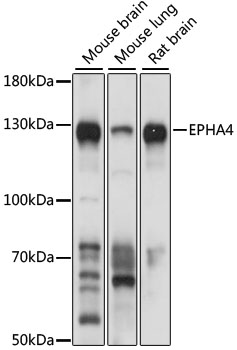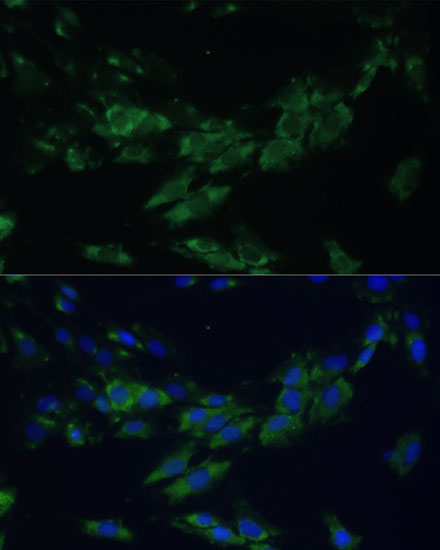Anti-EPHA4 Antibody (CAB8346)
- SKU:
- CAB8346
- Product type:
- Antibody
- Application:
- WB
- Reactivity:
- Mouse
- Rat
- Host Species:
- Rabbit
- Isotype:
- IgG
- Research Area:
- Cell Biology
Description
| Antibody Name: | Anti-EPHA4 Antibody |
| Antibody SKU: | CAB8346 |
| Antibody Size: | 20uL, 50uL, 100uL |
| Application: | WB IF |
| Reactivity: | Human, Mouse, Rat |
| Host Species: | Rabbit |
| Immunogen: | Recombinant fusion protein containing a sequence corresponding to amino acids 887-986 of human EPHA4 (NP_004429.1). |
| Application: | WB IF |
| Recommended Dilution: | WB 1:500 - 1:2000 IF 1:50 - 1:200 |
| Reactivity: | Human, Mouse, Rat |
| Positive Samples: | Mouse brain, Mouse lung, Rat brain |
| Immunogen: | Recombinant fusion protein containing a sequence corresponding to amino acids 887-986 of human EPHA4 (NP_004429.1). |
| Purification Method: | Affinity purification |
| Storage Buffer: | Store at -20°C. Avoid freeze / thaw cycles. Buffer: PBS with 0.02% sodium azide, 50% glycerol, pH7.3. |
| Isotype: | IgG |
| Sequence: | SLKR TGTE SSRP NTAL LDPS SPEF SAVV SVGD WLQA IKMD RYKD NFTA AGYT TLEA VVHV NQED LARI GITA ITHQ NKIL SSVQ AMRT QMQQ MHGR MVPV |
| Gene ID: | 2043 |
| Uniprot: | P54764 |
| Cellular Location: | Cell junction, Cell membrane, Cell projection, Early endosome, Single-pass type I membrane protein, axon, dendrite, postsynaptic cell membrane, postsynaptic density, synapse |
| Calculated MW: | 104kDa/109kDa |
| Observed MW: | 110kDa |
| Synonyms: | EPHA4, HEK8, SEK, TYRO1 |
| Background: | This gene belongs to the ephrin receptor subfamily of the protein-tyrosine kinase family. EPH and EPH-related receptors have been implicated in mediating developmental events, particularly in the nervous system. Receptors in the EPH subfamily typically have a single kinase domain and an extracellular region containing a Cys-rich domain and 2 fibronectin type III repeats. The ephrin receptors are divided into 2 groups based on the similarity of their extracellular domain sequences and their affinities for binding ephrin-A and ephrin-B ligands. Multiple transcript variants encoding different isoforms have been found for this gene. |
| UniProt Protein Function: | EphA4: a tyrosine kinase receptor of the Eph family. Receptor for members of the ephrin-A family. Binds to ephrin-A1, -A4 and -A5. Binds more poorly to ephrin-A2 and -A3. May play a role in hindbrain pattern formation. The Eph receptor tyrosine kinase family, the largest in the tyrosine kinase group, has fourteen members. They bind membrane-anchored ligands, ephrins, at sites of cell-cell contact, regulating the repulsion and adhesion of cells that underlie the establishment, maintenance, and remodeling of patterns of cellular organization. Eph signals are particularly important in regulating cell adhesion and cell migration during development, axon guidance, homeostasis and disease. EphA receptors bind to GPI-anchored ephrin-A ligands, while EphB receptors bind to ephrin-B proteins that have a transmembrane and cytoplasmic domain. Interactions between EphB receptor kinases and ephrin-B proteins transduce signals bidirectionally, signaling to both interacting cell types. Eph receptors and ephrins also regulate the adhesion of endothelial cells and are required for the remodeling of blood vessels. |
| UniProt Protein Details: | Protein type:EC 2.7.10.1; Kinase, protein; Protein kinase, tyrosine (receptor); Membrane protein, integral; Protein kinase, TK; TK group; Eph family Chromosomal Location of Human Ortholog: 2q36.1 Cellular Component: Golgi apparatus; cell surface; endoplasmic reticulum; integral to plasma membrane; postsynaptic density; dendrite; dendritic spine; perikaryon; postsynaptic membrane; mitochondrial outer membrane; axon; early endosome membrane; cytoplasm; plasma membrane; nerve terminal; neuromuscular junction; cell junction; filopodium Molecular Function:identical protein binding; protein binding; ephrin receptor binding; transmembrane-ephrin receptor activity; GPI-linked ephrin receptor activity; PH domain binding; ATP binding; protein kinase activity Biological Process: axon guidance; positive regulation of JNK activity; peptidyl-tyrosine phosphorylation; negative regulation of axon regeneration; protein amino acid autophosphorylation; motor axon guidance; regulation of astrocyte differentiation; positive regulation of dendrite morphogenesis; glial cell migration; regulation of axonogenesis; adult walking behavior; ephrin receptor signaling pathway; corticospinal tract morphogenesis; cell adhesion |
| NCBI Summary: | This gene belongs to the ephrin receptor subfamily of the protein-tyrosine kinase family. EPH and EPH-related receptors have been implicated in mediating developmental events, particularly in the nervous system. Receptors in the EPH subfamily typically have a single kinase domain and an extracellular region containing a Cys-rich domain and 2 fibronectin type III repeats. The ephrin receptors are divided into 2 groups based on the similarity of their extracellular domain sequences and their affinities for binding ephrin-A and ephrin-B ligands. [provided by RefSeq, Jul 2008] |
| UniProt Code: | P54764 |
| NCBI GenInfo Identifier: | 4758280 |
| NCBI Gene ID: | 2043 |
| NCBI Accession: | NP_004429.1 |
| UniProt Secondary Accession: | P54764,Q2M380, |
| UniProt Related Accession: | P54764 |
| Molecular Weight: | 109,860 Da |
| NCBI Full Name: | ephrin type-A receptor 4 |
| NCBI Synonym Full Names: | EPH receptor A4 |
| NCBI Official Symbol: | EPHA4 |
| NCBI Official Synonym Symbols: | SEK; HEK8; TYRO1 |
| NCBI Protein Information: | ephrin type-A receptor 4; EK8; EPH-like kinase 8; TYRO1 protein tyrosine kinase; tyrosine-protein kinase TYRO1; tyrosine-protein kinase receptor SEK; receptor protein-tyrosine kinase HEK8 |
| UniProt Protein Name: | Ephrin type-A receptor 4 |
| UniProt Synonym Protein Names: | EPH-like kinase 8; EK8; hEK8; Tyrosine-protein kinase TYRO1; Tyrosine-protein kinase receptor SEK |
| Protein Family: | Ephrin type-A receptor |
| UniProt Gene Name: | EPHA4 |
| UniProt Entry Name: | EPHA4_HUMAN |




